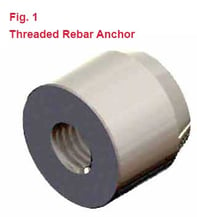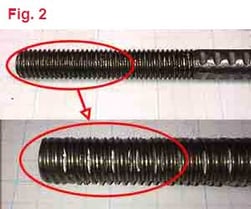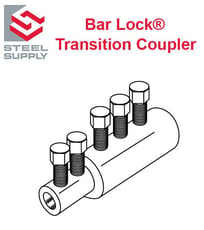As Rebar Couplers become more commonplace in Steel Construction several problems can arise. A common one is varying diameter rebar. To the steel fabricator, typically welding the Bar Lock® Rebar Anchors to the columns in the shop this would appear irrelevant. The catch occurs if the anchors are threaded and one solution is the Transitional Coupler.
common one is varying diameter rebar. To the steel fabricator, typically welding the Bar Lock® Rebar Anchors to the columns in the shop this would appear irrelevant. The catch occurs if the anchors are threaded and one solution is the Transitional Coupler.
Example
Using as an example a job that calls for #5 rebar (5/8” diameter) through-out the concrete slab, and has the rebar anchored at every column with a D106 Weldable Coupler. (Fig. 1)
 (Fig. 2) The 5/8” diameter rebar does not have a full 5/8” body. Threading it will leave a choppy thread that does not make full contact with the rebar anchor and will not reach full pull-out strength.
(Fig. 2) The 5/8” diameter rebar does not have a full 5/8” body. Threading it will leave a choppy thread that does not make full contact with the rebar anchor and will not reach full pull-out strength.
This can be resolved by creating an Upset Thread. This is a process that expands the diameter of the rebar, which allows for a full thread.
Or, the rebar diameter can be increased, in this case to # 6, (3/4” diameter). Starting then with a #6 rebar, one end can be milled down to an actual full diameter 5/8” bar, which will thread correctly. This is only done on the piece that will connect to the anchor. This section can be as long or short as the erector chooses. Then, using a Bar Lock® D220 Transition Coupler the blunt end the #6 rebar can be stepped back down to #5.
is only done on the piece that will connect to the anchor. This section can be as long or short as the erector chooses. Then, using a Bar Lock® D220 Transition Coupler the blunt end the #6 rebar can be stepped back down to #5.
Dayton Superior Bar Lock® Transition Couplers can be produced in Type I or Type II capacities. Any combination of diameters can be used. It is important to note the specifications and strength of the smaller diameter coupler will be the functional limit of this unit.
Also note, all Transition Couplers are made to order. It is important to order with adequate lead time.
More information regarding Rebar Anchors and Couplers visit our website.




